
I. Introduction: Can a physicist really read the Bible?
In the Gospels, Jesus occasionally uses physical phenomena to illustrate spiritual truths. He says, "I am the light of the world. Whoever follows me will never walk in darkness, but will have the light of life."[1] "The wind blows wherever it pleases. You hear its sound, but you cannot tell where it comes from or where it is going. So it is with everyone born of the Spirit."[2] "Whoever believes in me, as the scripture has said, streams of living water will flow from within him."[3]
Certainly no great sophistication in the physical sciences is needed to appreciate these references. They have an immediate, striking significance based on out everyday experience. The question is, do these comparisons have a meaning below the surface? If we have a deeper scientific understanding of the physical phenomena being referred to, can we obtain more profound spiritual insight? Further, we may ask: is it valid to make other comparisons between physical phenomena and Biblical spiritual concepts? The point of this paper is to argue that both extension of Biblical comparisons and construction of new ones can lead to significant spiritual insights, and open up for us a new dimension of intimacy with God.
In this investigation, I do not pretend to be objective. I cannot escape from the fact that I read the Bible through the eyes of a physicist. My contention is, that my scientific predisposition enriches my spiritual understanding. I will consider this paper successful if it stimulate others to search for spiritual insight within their own intellectual disciplines.
II. Presuppositions vis-a-vis God and the Bible
Before embarking on the main discussion, let me clarify the religious presuppositions on which my views are based. For those who don't share my views, I hope that you may still read this paper with some profit. I will deal largely with specific examples, which you may reinterpret to fit into your own conceptual framework.
I believe that God exists; that He is the author of the physical universe; and that He is personal in the sense that he possesses many traits which we normally ascribe only to human beings: for instance, God loves me, knows me, and communicates with me in various ways.
As to the Bible, I believe that it accurately represents God's thoughts and attitudes. If a 'myth' is defined as "A story which is taken to manifest some aspect of the cosmic order"[4] , then the Bible is replete with myths. Nonetheless, I hold that biblical accounts of the life of Jesus and the history of Israel are historically accurate. A vital component of the Biblical message is that God does express principles of cosmic order through personalized, extraordinary events in the lives of individuals and nations.
Though I have never seen a miracle on the order of the raising the dead, or walking on water, or changing water into wine, I still believe that Jesus did such things during his lifetime. In my life, there have only been "small" miracles, events that many people would call "luck" or "coincidence". My experiences may not be as impressive as those recorded in the Bible--nonetheless, they bear a certain similarity. The relative insignificance of my experiences does not undermine the historicity of Biblical miracles, but rather lend credence. In the same way, I have experienced earth tremors, but never an earthquake: nonetheless, my experience helps convince me that earthquakes are real.
III. Can we understand the Bible better than they could back then?
Let us now take up the first question mentioned above, namely whether the physical examples used by Jesus can be more deeply understood in the light of modern physics. It may be argued that Jesus was speaking to people with virtually no scientific sophistication. Why should we try to view Jesus' examples in the light of modern science, when Jesus' hearers had no recourse to these ideas? Jesus is speaking to people of His time, not ours. We are in danger of reading our own thoughts into Jesus' words, and the end product will be nonsense.
Nonetheless, in interpreting Biblical texts in light of modern insights, we are only following the practice of the Biblical writers themselves. The New Testament writers often invested Old Testament prophecies and events with significance that could not possibly have been perceived by the Old Testament sources themselves. Referring to the Israelites in the Exodus, Paul writes, "They all ate the same spiritual food and drank the same spiritual drink; for they drank from the spiritual rock that accompanied them, and that rock was Christ."[5] Certainly no one, before the coming of Jesus, would have dreamed of interpreting the rock which Moses struck as a type of the Messiah . The Gospel of Matthew is full of examples. Referring to the virgin birth, Matthew quotes Isaiah in support: "All this took place to fulfill what the Lord had said through the prophet: 'The virgin will be with child and will give birth to a son, and they will call him Immanuel' -- which means, 'God with us'."[6] Referring to the return of Jesus' family from Egypt, he writes "And so was fulfilled what the Lord had said through the prophet: 'Out of Egypt I called my son.'"[7]
Jesus himself engaged in such 'revisionist' interpretation of the Scriptures. After his resurrection, he says to his disciples, 'How foolish you are, and how slow of heart to believe all that the prophets have spoken! Did not the Christ have to suffer these things and then enter his glory?' And beginning with Moses and all the Prophets, he explained to them what was said in all the Scriptures concerning himself."[8]
Peter justifies the reinterpretation of Old Testament scripture in the light of Christ's life as follows:
Thus the events and pronouncements recorded in the Old Testament had their own significance, independent of the understanding of the writers. God arranged the events--only much later did men have the means to grasp God's intentions in the arrangement.
As far as the teachings of Jesus are concerned, he did not necessarily expect his hearers to understand him. Repeatedly Jesus says, "He who has ears to hear, let him hear."[10] Is it not possible that we, through our more extensive knowledge of the physical world, have 'ears' that Jesus' audience did not?
IV. The heavens declare the glory of God
Our argument that Biblical images can be understood scientifically is based on the premise that these images have significance beyond the immediate context in which they are used. When Jesus says, "I am the light of the world", we claim that Jesus is not just seizing on a convenient example: rather, he is indicating a physical analogy that God has placed in the world to illustrate His nature. It is not merely the particular surface features, but the entire phenomenon itself which brings insight into the character of God. If this is true, than a deeper study of light will lead to a deeper understanding of Jesus--and, if our science goes beyond the science of the Biblical authors, our understanding will also go beyond their understanding.
The Bible itself supports this view, that physical phenomena themselves embody spiritual truths. Paul declares, "For since the creation of the world God's invisible qualities--his eternal power and divine nature--have been clearly seen, being understood from what has been made, so that men are without excuse."[11] In the Psalms, we may find the following affirmation: "The heavens declare the glory of God; the skies proclaim the work of his hands. Day after day they pour forth speech; night after night they display knowledge. There is no speech or language where their voice is not heard. Their voice goes out into all the earth, their words to the ends of the world." Immediately following this statement, the psalmist gives a particular example of the glory of God revealed in nature: "In the heavens he has pitched a tent for the sun, which is like a bridegroom coming forth from his pavilion, like a champion rejoicing to run his course. It rises at one end of the heavens and makes its circuit to the other; nothing is hidden from its heat."[12] This passage may be taken as a reference to the Messiah: it is entirely consistent with other Biblical texts which compare the Messiah to the sun, or to a bridegroom.[13]
V. Learning from the mistakes of the past
So far, we have been going over old ground. Particularly in the 18th and 19th centuries, many physicists who were professing Christians attempted to use scientific facts to show "the heavens declare the glory of God". Much of what was written then appears ludicrous now, based as it was on physical theories which have since become outdated. James Clerk Maxwell recognized the riskiness of this enterprise: "I think that the results which each man arrives at in his attempts to harmonize his science with his Christianity ought not to be regarded as having any significance except to the man himself, and to him only for a time, and should not receive the stamp of society. For it is of the nature of science, especially of those branches of science which are spreading into unknown regions to be continually ... [Here the unfinished draft ends; the missing word, one assumes, must imply change.]"[14] Still, Maxwell himself made such attempts: in a public lecture, referring to molecules (or atoms), he stated:
Granted it is risky to express religious ideas in terms of scientific examples. But we should not move to the other extreme and deny the contribution that science can make to religious faith. Physical theories give us temporary, provisional ways of looking at the world -- and in the same way, they may provide us with temporary, provisional ways of conceiving of God. As my understanding expands, the limitations and flaws of previously-held concepts become apparent. No specific application of science to the realm of faith should be preserved as an idol, but rather used as a tool, and discarded when the tool outlives its usefulness. A certain kind of humility is necessary: as the Psalmist says, "The Lord guides the humble in what is right, and teaches him his way."[16] I must recognize that I am not and can never be objective; and that I have an unavoidable tendency to abuse the facts by cramming them into the pigeonholes of my own preconceptions.
At very least, physicists who ponder the theological
implications of their theories may derive creative inspiration for new
physics. The three acknowledged giants of physics-- Newton, Maxwell, and
Einstein--were all deeply spiritually-minded, and spiritual preoccupations
certainly played a part in shaping their physical theories. The modern
physical picture first took shape at the hands of people who acknowledged
a single Creator--was their belief a useful fiction, or a profound truth?
VI. A road map to what follows
Having justified (I hope) my general approach, I will now attempt to intertwine two strands, one based on physics, and one based on the Bible (see Figure 1). In conclusion, I will advance some practical consequences which I believe spring from the resulting merger.
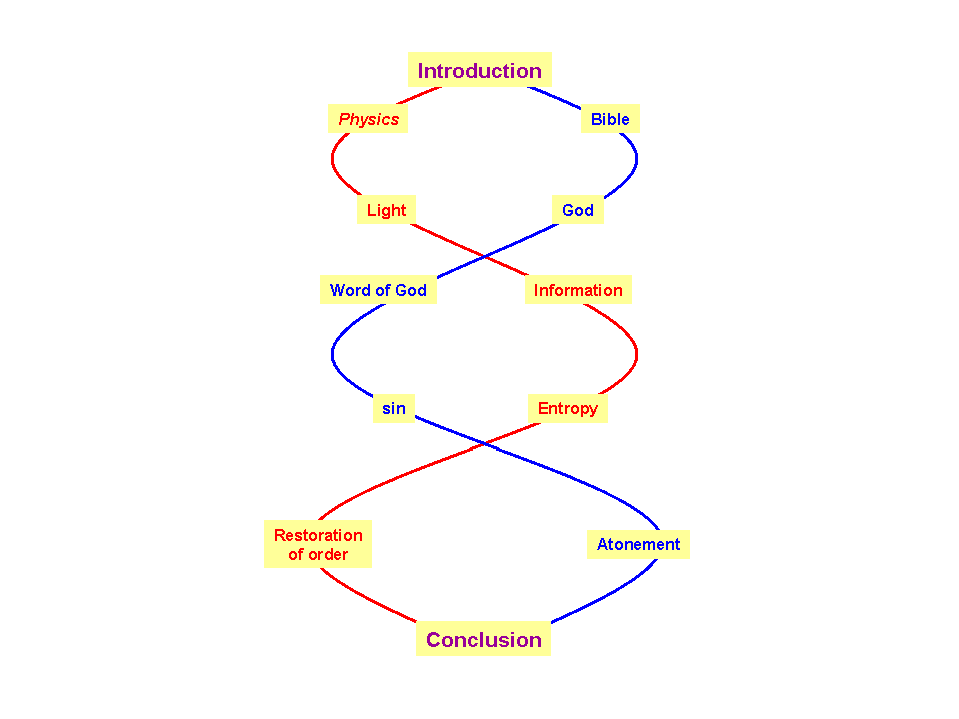
Figure 1 Schematic outline of this article
VII. Light in the Bible
We have already mentioned that Jesus announced Himself to be the light of the world.
Throughout the Bible, light is frequently associated
with God. God's first words in the creation were, "Let there be light"
(Gen. 1:3); in the Psalms, we find, "The LORD is God, and he has made his
light shine upon us"[17]; in his final description of the Holy City, the
new Jerusalem, John writes, "The city does not need the sun or the moon
to shine on it, for the glory of God gives it light, and the Lamb is its
lamp."[18] Psalms in the Old Testament, and the Johannine writings in the
New Testament are especially notable in their frequent juxtapositions of
light with God and His Son Jesus.[19]
VIII. The place of light in physics
Within physics, light has played two central roles: it has served both as a prototypical example; and as a means of communicating of information. In the following discussion, we will provide illustrative examples for these characterizations.
In 1861, James Clerk Maxwell boldly advanced the following claim: "Light consists in the transverse undulations of the same medium which is the cause of electric and magnetic phenomena."[20] Maxwell's conclusion was based on his detailed mathematical description of electricity and magnetism. His theory correctly predicted the velocity of light.
In 1887, H. Hertz detected radio waves, confirming
that visible light was only a special case of a more general phenomenon,
namely electromagnetic radiation. Electromagnetic radiation may be described
as an oscillating electromagnetic field; where an electromagnetic field
is an assignment of an electric field vector and magnetic field vector
to each point of space and time. In Figure 2 we have given a schematic
illustration of an electromagnetic radiation field. Visible light may be
identified with electromagnetic radiation within a small 'window' of frequencies,
as shown in Figure 3. The color of the light is determined by the frequency
of the radiation.
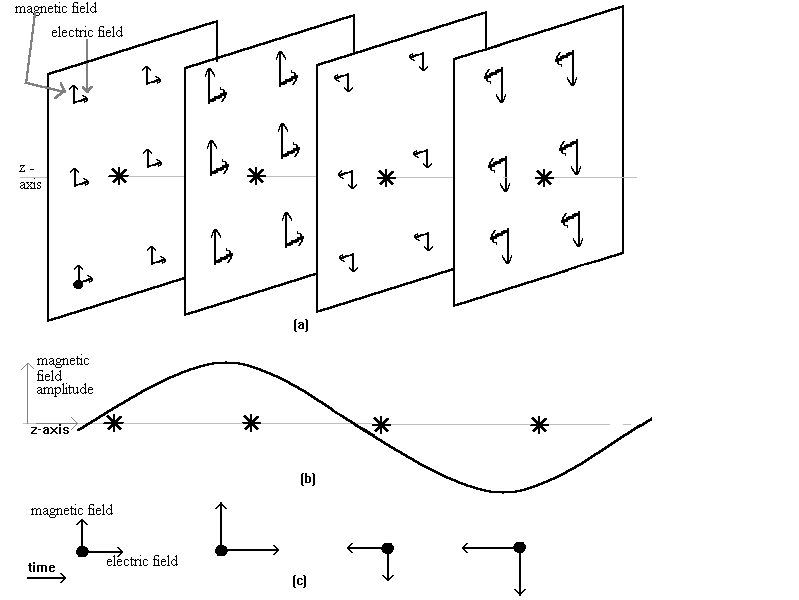
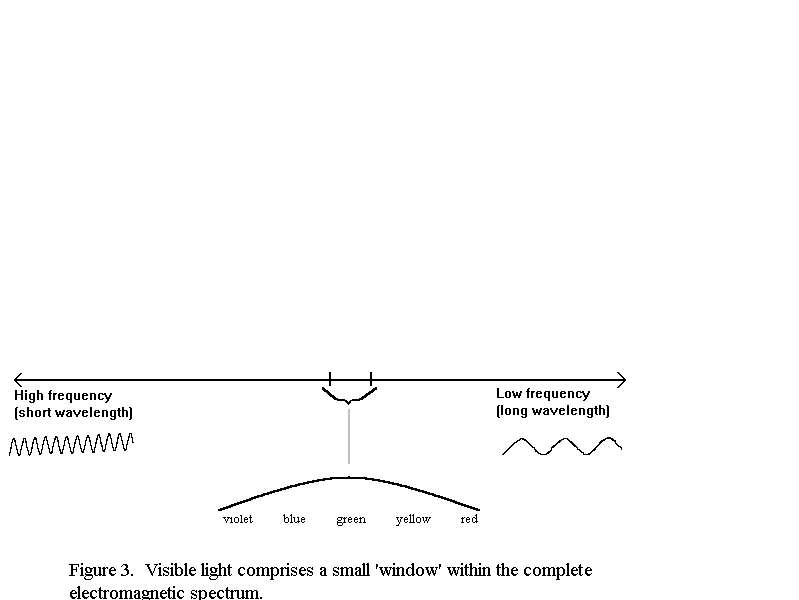
In the following discussion, we will use the term 'light' loosely, to denote any type of electromagnetic radiation.
Prior to Maxwell, for many years there had been
an extended debate about whether light was fundamentally a wave or particle
phenomenon. It was hard to make a judgment between the two: in geometrical
optics, which is the study of light passing through lenses and bouncing
off mirrors, the predictions of the wave and particle theories were identical,
as depicted in Figure 4(a). Nonetheless, even before the time of Maxwell,
the proponents of the wave theory had won the field. Oddly enough, within
forty years after Maxwell it was found that light did in certain situations
exhibit particulate properties, which could not be explained by a wave
theory. This apparent paradox led to the question, Does matter exhibit
the same wave-particle ambiguity? In 1924, Louis de Broglie conjectured
that matter was also a wave phenomenon; and subsequently E. Schrodinger
in 1925 formulated a wave equation for matter. Schrodinger's entire argument
was based on an analogy with light, and is shown schematically in Figure
4(b). Maxwell's equations gave the detailed picture for light: but in the
realm of geometrical optics, these equations reduce to a much simpler equation,
namely Fermat's 'least time' principle. The Newtonian equations which describe
the motion of massive particles could be formulated as a 'least action'
principle, which was similar in form to the 'least time' principle. So
Schrodinger attempted to work backwards from the 'least action' principle,
and conjecture the wave equation for matter which gave the detailed picture
for matter, just as Maxwell's equations gave the detailed picture for light.


To summarize the above discussion: Maxwell's theory of electromagnetic fields (the general phenomenon which subsumes light) was the prototype for the quantum description of matter. In both theories, the physical phenomena being described are modeled by oscillating fields. Also, in both theories, the medium in which these oscillations are taking place is entirely unspecified.
This is not the end of the story. As we have mentioned,
light at times appears to be a particle phenomenon. These particles are
called photons--quanta of electromagnetic radiation. To explain this behavior,
a quantized version of the classical electromagnetic field was developed.
This theory is phrased, not in terms of the measurable electric and magnetic
fields themselves, but in terms of a 'potential' field from which the measurable
fields can be derived. Although the potential field uniquely determines
the measurable fields, there is some ambiguity in the choice of potential
field: many different potential fields correspond to the same configuration
of measurable fields (see Figure 5). We are free to choose any of these
physically indistinguishable potential fields to describe the physical
situation at hand. This freedom of choice is called a 'local gauge freedom':
and this type of theory is called a 'local gauge field theory'. All modern
fundamental theories of physics (including General Relativity) are local
gauge field theories.

Particles do not exist in isolation, so theories were formulated to describe the interactions of different kinds of particles with each other. Matter was described in terms of quantum fields: so theories of interacting quantum fields were developed. The first successful theory of this kind was quantum electrodynamics (Q.E.D.) which explains the interaction of the electromagnetic field with matter. Q.E.D. has provided science with its most accurate verified prediction, namely, the magnetic moment of the electron was accurately predicted to within a hundred millionth of a percent.
In Q.E.D., the local gauge freedom has far-reaching consequences. The matter fields exhibit a local gauge ambiguity, just as does the electromagnetic field: these ambiguities are found to exactly compensate each other, in an amazing fashion! In some sense, the existence of the electromagnetic field was found to be a necessary consequence of the nature of the matter field (see Figure 5).
Q.E.D. was prototypical for other local gauge field theories. One notable example is the "Standard Model" due to Glashow, Salam, Weinberg, and others, which describes the 'weak' interaction that influences the dynamics of electron-like particles (leptons). Part of the Standard Model includes the so-called "Higgs mechanism", by which the presence of massive vector particles is explained. This mechanism had previously been used to explain an electromagnetic phenomenon (the behavior of the electromagnetic field within a superconductor)--so once again, an electromagnetic application provided a prototype for a critical aspect of a fundamental theory of matter.
One reason why Q.E.D. was so successful and relatively easy to come by was that it was "renormalizable", i.e., infinities which arose in the theory could be submerged, and did not affect observable quantities. The electromagnetic field continually reacts and re-reacts with the 'bare' matter fields, giving rise to infinite interaction energies (see Figure 6). But we never observe the isolated matter field, completely divorced from the surrounding electromagnetic field. If we only consider the couple fields, without separating the 'bare' matter from the associated electromagnetic field, then the infinities do not appear in calculations of physically observable quantities.

We have given above several examples of how light has provided prototypical theories which have served as models for fundamental theories of matter. But this is not the only role that light has played in physics. Light is also the primary means by which information is communicated. Virtually all physical measurements are made by means of electromagnetic radiation. The quantum behavior of atoms was discovered via their spectrum, i.e., the electromagnetic radiation they produced. In astrophysics, virtually all data pertains to electromagnetic radiation, from the spectra of stars to cosmic microwave background radiation (which provides the strongest argument in support of the "Big Bang" theory).
Light's function as communicator of information is fundamental in the theory of relativity, which is based on the premise that observers accurately locate events in space and time by means of light.
Figure 7(a) shows the setup of a hypothetical experiment in which two relatively moving observers watch a pair of lights which flash instantaneously (NOTE that the times and distances shown are those measured by Mr. Telescope, who is stationary with respect to the experimental apparatus). Figure 7(b) shows the different observers' photographs of the sequence of events. Both observers recognize that their photographs are distorted because of effects caused by the finite speed of light: but even after correcting for these effects, the observers still differ in their interpretations, as shown in Figure 7(c). The observer on the ground describes the two lights as flashing simultaneously; while the observer on the rocket insists the right-hand light flashed first. One observer also assigns a smaller separation distance between the lights than does the other. In fact, concepts like "length", "simultaneous", and "time period" have no absolute significance, but rather depend on the observer. However, there are still concepts with absolute significance. The speed of light will be measured the same by all observers. The 'space time separation' of two events may be defined as an absolute quantity.
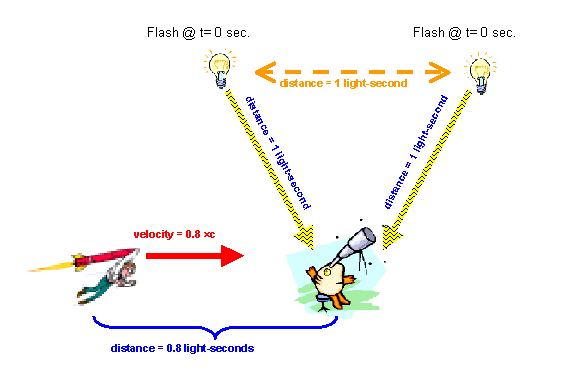
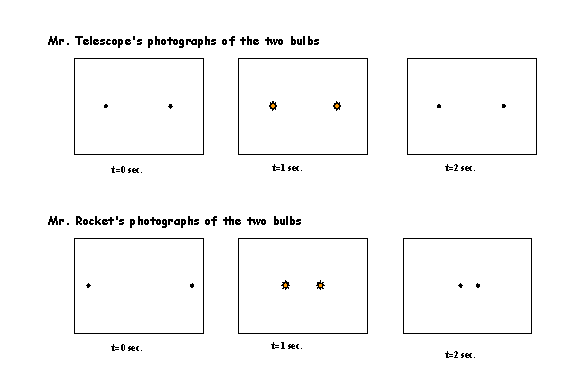
Figure 7(b) Photographs taken by Mr. Telescope and Mr. Rocket
of the flashing lights.

Figure 7(c) Physical interpretation of the experiment by the
two observers.
The translation between the two different observers' points of view can be made much more easily and more comprehensibly if they no longer use "space" and "time" as reference axes, but rather construct coordinate grids based on the trajectories of light rays, as shown in the two Figures below. Then the change between observer's points of view is seen to be a simple "squishing" in one direction and "stretching" in the other direction of the light-based coordinate grid.
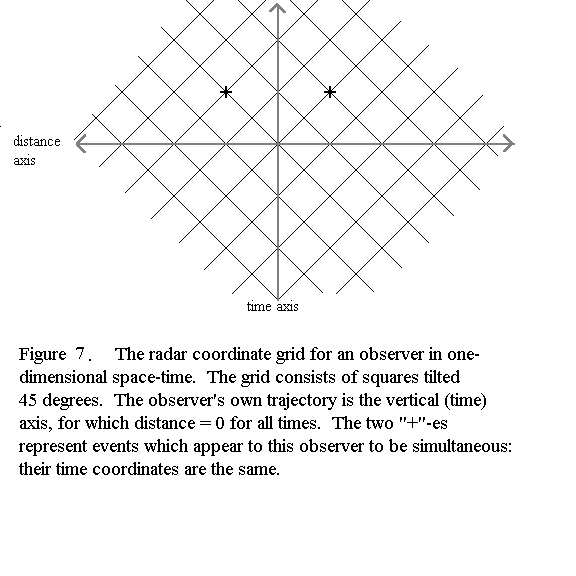
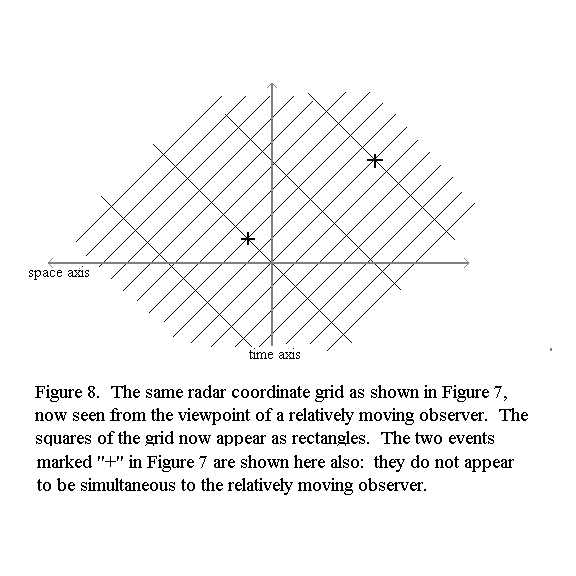
IX. Physics and Bible compared
We have said that, in the Bible, light is associated with God. Can what we have said about the physics of light tell us anything about the nature of God?
Certainly, several of the properties of light we have mentioned are reminiscent of Biblical attributes of God. Like the electromagnetic field, God is omnipresent:
"A man's steps are directed by the LORD. How then can anyone understand his own way?"[23]
We have seen that the understanding of light has consistently given rise to prototypical theories which lead to deep insight into the fundamental nature of the entire material universe. In the same way, in Biblical thought all knowledge begins with knowledge of God: "The fear of the LORD is the beginning of wisdom, and knowledge of the Holy One is understanding."[25] Light has repeatedly proved to be a fundamental phenomenon and not a secondary effect, such as the apparent motion of the sun around the earth or the cessation of motion of bodies subject to frictional forces. In the history of physics, secondary effects have frequently been mistaken for fundamental phenomena (witness the two previous examples). Needless to say, the fundamental nature of light could not possibly have been known at the time of Jesus. This fact supports the contention that the Biblical comparison of light with God is God's intention, not merely man's device. God is not an artifact of the mind of man--indeed God created man, and not vice versa.
We have shown that in physics, light is the primary vehicle for the communication of information. Light provides the very reference frame by which all events are assigned a location. In the same way, the Biblical God Himself (and His visible exemplification Jesus Christ) provide the ultimate reference by which we must orient ourselves spiritually and morally. Relativity has been cited in support of moral relativism[25], and the argument runs as follows: just as different observers perceive physical events differently, so different people have different, but equally valid , moral viewpoints. Certainly relativity shows that the measurements of different observers will differ--but it also provides for an objective means of comparing the different measurements, to check for their consistency. This comparison is most easily effected when observers place their observations within a conceptual framework provided by light, and not by the conventional, relative concepts of space and time. In the same way, Jesus Christ Himself affords the only sure means for comparing different moral and theological viewpoints, to ascertain whether or not they are consistent. Jesus Himself indicates that the moral viewpoint afforded by the Mosaic Law was relative and local, and not absolute. Jesus declared all foods clean[27] Jesus proclaimed Himself as Lord of the Sabbath[28] Jesus quoted the law, and then said, "but I say to you ..."[29]
The dilemma of the first-century Church vis-à-vis
the Gentiles[30] is analogous to the dilemma of the common person who encounters
relativity for the first time. The apostles took the Law and Jewish customs
(in particular, circumcision) as absolute moral imperatives. Nonetheless,
when God dealt with Peter on this point, He said, "What God has called
clean, let not man call unclean"[31] In other words, moral imperatives
must all be determined in direct relation to God. Paul says, "Love is the
fulfillment of the law"[32] which complements John's statement that God
is love.[33]
X. Information and the Word of God
In the previous section, we made it clear that in physics there is a close connection between light and information. Specifically, the understanding of light yields information about the inner workings of the physical world; and within the physical world, light is the primary means the means by which physical information is communicated. Interestingly, in the Bible, Jesus is also called the Word of God, which connotes a similar information-bearing aspect.[34]
What is the meaning behind this expression, the
Word of God? John and Paul both say that all things were created by Jesus
[35] and in Genesis, God spoke the worlds into existence. The world is
an expression of God's intention; and Jesus expresses God's intentions
and makes them known to us, as He said: "Everything I have learned from
my Father I have made known to you."[ 36] Jesus came to restore fellowship
between God and man, that is, to restore the channel of open communication
which was broken in the Garden of Eden.[37]
XI. Information, uncertainty, entropy
In order to probe the possible ramifications of Jesus being the Word of God, we will provide some background in information theory. Here we only present aspects which are relevant to our purpose: for a thorough treatment, we recommend [38]
In a computer, all information is ultimately expressed as strings of 0's and 1's. For example, the 26 English letter in English, can all be represented by strings of 5 0's and 1's, e.g. a=00000; b=00001; c=00010; ... z=11001. A single binary digit (0 or 1) is called one bit of information. So in some rough sense, any information-bearing message can be encoded as a string of bits. We define the information of a message to be the number of bits in its binary encoding. (Here we have sidestepped the fact that there is certainly not a unique scheme for binary encoding: for instance, we might encode the word "dog" with 5 bits or 5 million bits. For a more precise formulation, see [34].)
Now suppose I receive a letter in the mail. Before I open it, I'm not exactly sure what the letter says. However, from the return address I know whom it's from, and from the feel I can tell roughly how long the letter is, so I have some idea of what it could be about. Based on these prior indications, I may compute the expected value of the information (as defined in the previous paragraph) which I will gain when I read the letter (Reference [34] gives a mathematically rigorous definition of expected value). The expected information contained in the message is called the entropy of the message. Thus entropy can be equated with uncertainty. The more uncertain I am about the contents of the letter, the greater its entropy. The more prior information I have about the contents, the less its entropy.
In physical systems, entropy is usually associated
with disorder. This is because in physical systems, entropy is information
which is inaccessible to measurement[39]. Thus, a physical system
with high entropy is like a BIG letter which can't be opened: it contains
a lot of information (for instance, it would take a LOT of computer memory
to store the detailed information about the motion of all the air molecules
in this room), but there is no way for us to find out what it is.
XII. The physical world as a message from God
According to the Bible, God spoke the heavens and the earth into being--so I can think of heaven and earth as a message from God. Let us (conceptually) represent the information God expressed at the moment of creation as a string of 0's and 1's. As time evolves, the world changes, so the message changes. If we could observe the entire world at regular time intervals, and extract all the information which is present at each sampled time, we would get a sequence of binary strings, such as shown in Figure 9. Since the physical world is largely causal, we expect that each binary string will depend to a large extent on its immediate predecessor. If we say that each string depends entirely on its predecessors, we are forced into a Deistic view of the universe, in which the entire future history of the universe is determined from the start, with no room either for divine initiative or for free will. Thus, we suppose instead that there is some probability for each bit to change spontaneously from 0 to 1 or from 1 to 0, and these changes are not governed by deterministic rules applied to preceding information. But then, we run into another problem. How can the original message be preserved? It seems that the spontaneous changes will progressively 'garble' the message, until the original message is completely obscured. Indeed, at one time it was thought that, in mathematical systems similar to the "toy universe" we describe, the original message would eventually become totally incomprehensible.[40] However, Peter Gacs[41] has recently given an example of a system where this complete disordering[42] can be avoided. In Gacs' example, the original message is encoded in a 'hierarchically redundant', fashion: the same message is encoded, first with single bits, then with groups of bits, then with groups of these groups, and so on. Hierarchical redundancy is illustrated in Figure 10. The 'seed' message is '1011'. The seed itself is used to encode the bit '1', while the bit--reversed version '0100' encodes '0'. Thus, on the next level, the seed is re-encoded as '1011 0100 1011 1011'--which in the following level encodes '1', while its bit-reverse encodes '0'; and so on.[43]
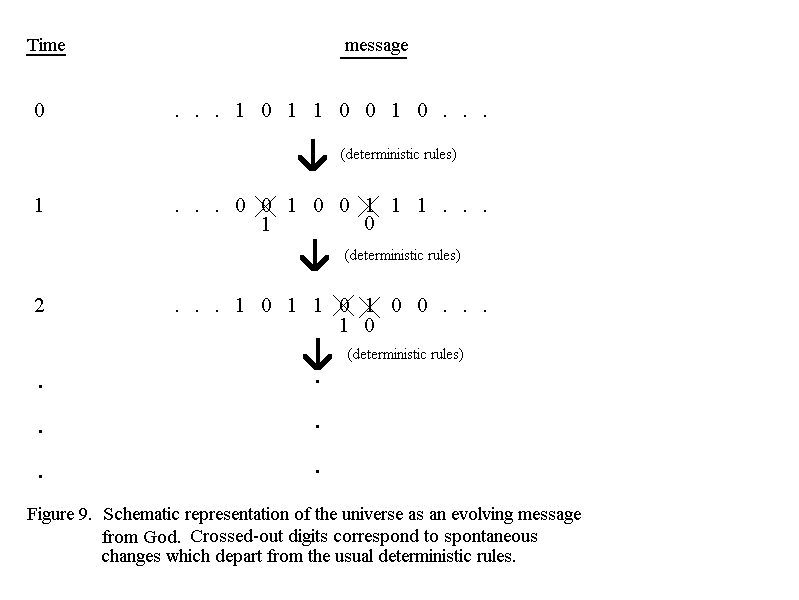
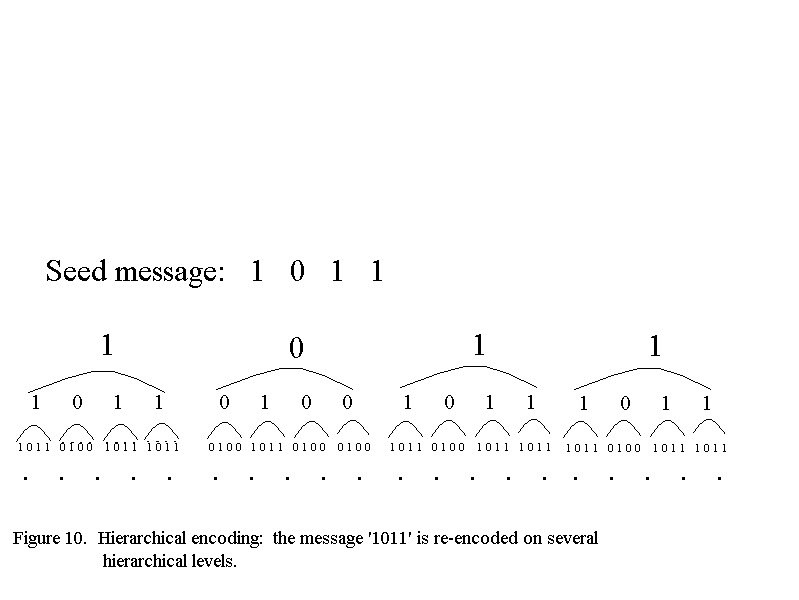
Interestingly enough, this kind of hierarchical structure appears frequently in nature. Consider the ubiquity of wave phenomena, on all scales of physics: from sub-nuclear to nuclear to atomic to molecular to macroscopic to astronomical. Frequently theories can be carried over bodily from one regime to another--examples would be the 'planetary' model of the electron; the 'ball and spring' model, which is applied on an atomic level to explain the behavior of crystals; the quantum mechanical theory of the harmonic oscillator, which is used to explain both molecular behavior and behavior on the particle physics level. The existence of this kind of hierarchical encoding is consistent with a God who wants to express His nature to us through what He has created. He wants us to decode His message: "It is the glory of God to conceal a matter; to search out a matter is the glory of kings."[44] It is also consistent with a God who wants to allow us freedom to make decisions and employ initiative, without being unduly confined by the requirement of preserving His message.
God allows freedom, God provides for uncertainty
in the universe. Entropy does increase: but this does not lead to increased
incoherence. If, on a certain level, His message can no longer be read
clearly, then going up one level the message is still comprehensible.
XIII. Pandora's box of snowflakes and the Fall of humanity
We can identify the Biblical concept of 'sin' with a corruption of God's message: "Everyone who sins breaks the law; in fact, sin is lawlessness"; "Anyone, then, who knows the good he ought to do and doesn't do it, sins."[45]. But have we not just finished saying that God's system of coding allows us to exercise our free will, and make changes in God's message? Apparently, some changes are allowed, and some are not. In order to understand this situation, let us consider a physical 'toy model' of our spiritual situation.
Imagine a box full of snowflakes, as illustrated in Figure 11(a). Certainly there is some water vapor in the box, but suppose that the vapor pressure of the ice in the snowflakes is equal to the pressure of the vapor in the box, so the snowflakes and vapor are in equilibrium. The snowflakes and the vapor can then move about freely within the box, and the beauty and symmetry of the snowflakes is preserved. Indeed, some snowflakes may evaporate and others may condense from the vapor, so the situation is not static, but new symmetries appear, new beauties are manifested in the system.

Now suppose that there is a cork in this box which is removed, and the vapor is free to move into a much larger space, which was previously a vacuum (as shown in Figure 11(b)). The vapor begins to leak out of the original box, into this larger space. With less vapor, the evaporation of the snowflakes is no longer balanced by the condensation of vapor. Snowflakes evaporate and disappear, and none are re-formed to replace them. Eventually all the snowflakes disappear, no more apparent beauty or symmetry within the system, all is completely disordered motion.

This dissolution of beauty accords with the Biblical
picture of the origin of sin. Adam and Eve were tempted by the promise
of additional power and freedom--but what they reaped instead was additional
incoherence. In Paul's words, "Their thinking became futile and their foolish
hearts were darkened. Although they claimed to be wise, they became fools."[46]
In trying to define their own message, independent of God, they lost contact
with the original message of God, so lost the foundation of beauty and
symmetry within their own lives. They could not throw off God; they could
only corrupt their relationship with Him. They felt naked and fearful in
His presence [47], their fellowship with Him was broken, and the
free flow of information between God and man was disrupted. In addition
their defiant action, tiny though it appeared, lead to the disruption all
of creation, so the message of God was corrupted throughout the world.
The ground was cursed, thorns and thistles grew in place of more pleasant
flora[48]. Deserts were formed, wastelands developed. Too late Adam
and Eve realized that the inevitable consequence of the knowledge of good
and evil was the introduction of the latter into the world.[49]
XIV. Restoring the former glory
At this point the question arises: how can order, symmetry, and beauty be restored to such a system, once it is disrupted? First we return to our system of snowflakes, which is certainly the easier system to remedy! Here, the solution is simple, namely, lower the temperature of the larger box. Increased condensation will take place: a new balance between condensation and evaporation will be achieved, and the vapor will again crystallize. Unfortunately, there is no way to lower the temperature by operating exclusively within the system. When the cork was unstopped, the vapor molecules obtained much more freedom, with a corresponding enormous increase in uncertainty, that is, entropy. Lowering the temperature amounts to reducing this entropy: and according to the Second Law of Thermodynamics, the entropy of a closed system cannot be decreased. The entropy within the system might redistribute itself a little, local decreases in entropy may occur, but the total entropy can only increase.
Is there indeed no hope? Maxwell conceived of the existence of an enterprising little fellow who is now called "Maxwell's demon." The demon watches molecules as they go by, grabs them, and redirects their flight, in this way reducing the disorder (entropy) of the system. This appears to be a grand scheme for reducing entropy at no cost! Unfortunately, Maxwell's demon inevitably suffer the effects of the misdirected molecule. His own information is corrupted, his own entropy must increase. The same quandary appears in quantum mechanics--to correct a system, the correcting agent must necessarily bear the consequences of the initial incorrectness of the system.
The only way for the entropy of the system to
be reduced is to open it up to external influence. The system must be put
in contact with a source of low entropy, which can absorb the existing
entropy and expel it from the system. A refrigerator is an example of just
such an entropy-reducing mechanism: the fluid refrigerant alternately absorbs
entropy (heat) from the air space inside, and expels this entropy into
the room. Another example is afforded by the biosphere. The earth maintains
its high degree of biological order because the sun provides an external
source of low entropy. As explained in reference [50], photons come
from the sun in a comparatively low-entropy state (relatively fewer high-energy
photons), are absorbed by plants and re-emitted in a comparitively high-entropy
state (relatively many low-energy photons). The net entropy deficit
is what drives the entropy reduction of the biosphere.
XV. The atonement of Christ compared
Now we consider the parallel question of restoring this depraved world from the ravages of sin.
Apparently, sources of sin in the human system can be inactivated by death. Jesus says, "If your hand causes you to sin, cut it off."[51] Paul refers to the Old Covenant as the "ministry that brought death"[52]. The Egyptians who pursued the Israelites into the Red Sea died. The Israelites who rebelled in the wilderness died. The Canaanites who occupied the Promised Land all died. After Adam and Eve had eaten the forbidden fruit, God prevented them from eating the fruit of the tree of life.[53] Otherwise, they would have lived forever, and their corrupted bodies would have endured as sources of sin, eternal obstacles to fellowship with God. But by death, only the further spread of sin has been impeded. In the same way, amputation can prevent further damage, but cannot undo the damage which has been done; extinguishing hot coals in a fireplace can keep the room from getting hotter, but cannot make it any cooler.
Is death the only way out? Paul expresses the question, and then answers it: "What a wretched man I am! Who will save me from this body of death? Thanks be to God--through Jesus Christ our Lord."[54]
In his life on earth, Jesus Christ acted as a 'zero spiritual entropy' source of truth, which may be characterized as divine information.[55] This information came from outside the human world, by means of the Holy Spirit: the external nature of the information is shown at the moment of Jesus' baptism, when the heavens open and the Holy Spirit descended on Him like a dove[56] "God anointed Jesus of Nazareth with the Holy Spirit and power, and he went around doing good and healing all who were under the power of the devil."[57] By reversing the effects of 'spiritual entropy', Jesus showed himself to be a source of the opposite of uncertainty and entropy, namely truth and information.
Jesus' sinlessness was insufficient to save the
world. Sin in the world somehow had to be expelled , like the entropy in
our 'snowflake box' example. In order to eradicate sin and restore fellowship
between humanity and God, it was not enough for Jesus to do good: he had
to die. Just as the refrigerant carries off heat, just as the re-radiated
photons carry away entropy from the biosphere, Jesus had to take the sin
of the world into himself and die.[58] The fact that Jesus rose again,
by the power of the Holy Spirit[59] shows that the external source of truth
which empowered Him has not been exhausted, and is still available for
us to tap into.
XVI. Enter the Church
Now that Christ's work on earth is finished, where do we stand? Sin is still rampant, notwithstanding Jesus' atonement. There is more "spiritual entropy" left to be removed. More divine "information" or truth is needed. Numerous Biblical references indicate that the Church collectively and Christians individually serve as the sources of this information. The continuing process of redemption is illustrated in Figure 12. Jesus Christ, having the 'message of reconciliation'[60] within Himself, was empowered by the Holy Spirit to shine as a light in the world[61]. Those who received his message (e.g. the apostles), themselves were empowered by the Holy Spirit to shine with God's truth; and so the process continues. The same message of reconciliation which is found within each individual believer is also hierarchically re-encoded in the Church as a whole, the 'body of Christ'[62]. Thus both the individual believer and the Church as a whole serve as 'temples of the Holy Spirit'[63].
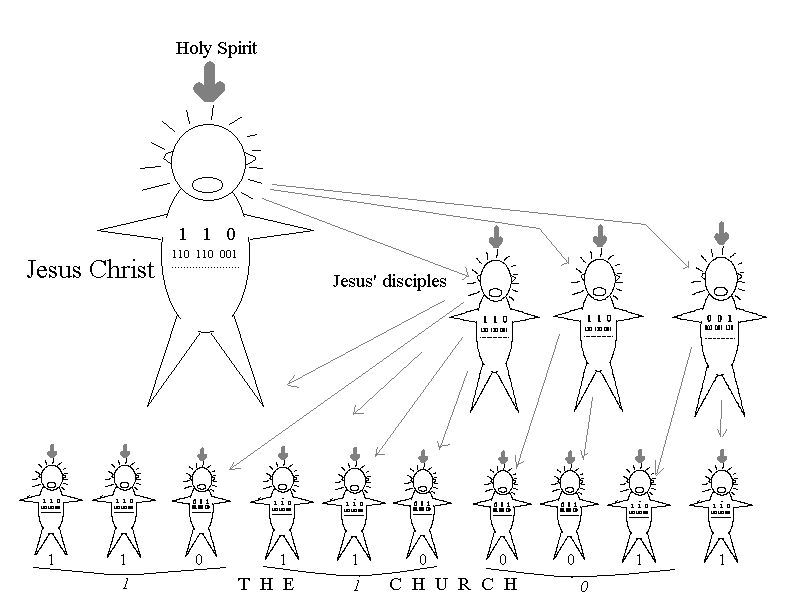
Jesus in saving the world was himself expressing
a message of God, a message of love, a message of God's desiring our reconciliation
unto Himself. In this sense, Jesus is the prototype, Jesus is the firstborn
of many brothers. When I receive Jesus as my Lord, this same message is
placed in my heart. So the same message which Jesus expressed in His life
and death, I too can express. I live as He lived; I die as He died[64].
Furthermore, the Church as a whole collectively expresses the same message.
XVII. Conclusions
In this paper, we have attempted to provide a precedent for the use of physics as a source of insight into spiritual, Biblical concepts. I have attempted to show that we may "consider the heavens, the work of Your fingers"[65] in a scientific sense, not just a poetic sense, to arrive at a deeper understanding of the Biblical God.
Our comparison of God with light suggests that light is a fundamental phenomenon, and the study of light should continue to bring about conceptual breakthroughs in physics.
By providing a physical model for sin, redemption, the Atonement, and the roles of the Christian and the Church within the world, we have attempted to translate the Christian gospel into the language of physics. This translation may serve as a point of contact between Christians and scientists of different faiths.
The physical model we have has many distinctives. It postulates a creator who both wants His creatures to understand Him through His creation, and wants them to freely act within His creation to constructively modify what He has made.
The model portrays sin as having an absolute significance, not a relative significance, in that it corrupts the intended message of God in an uncontrolled fashion. It portrays communications breakdown as a natural correlate of sin. Thus, sin involves a breakdown of communication between man and God; it is natural that it should be accompanied by the breakdown in communication between man and man. The story of the Tower of Babel[66] is a biblical example of this: other examples are strife between racial, ethnic, or other social groups; divorce; and other phenomena which accompany depersonalization, including promiscuity and crime. The fragmentation and lack of overall perspective in modern knowledge is another example of a natural accouterment of information breakdown; as is the sense of meaninglessness of life.
The model shows the ineffectiveness of legalism or religious ritualism in dealing with sin. No mechanism within the human system can be used to reduce sin: this statement finds its analogy in physics in the Second Law of Thermodynamics. Jesus Christ, however, could effectively deal with sin, because through the Holy Spirit he acted as an external source of truth, that is, of zero spiritual entropy. It was necessary, not only for Jesus to live a blameless life, but to die in order to remove sin from the world.
Jesus in acting this way is himself expressing
a particular message from God, the message of reconciliation. "All this
is from God, who reconciled us to himself through Christ and gave us the
ministry of reconciliation: that God was reconciling the world to himself
in Christ, not counting men's sins against them. And he has committed to
us the message of reconciliation. We are therefore Christ's ambassadors,
as though God were making his appeal through us. We implore you on Christ's
behalf: Be reconciled to God. God made him who had no sin to be sin for
us, so that in him we might become the righteousness of God."[67]
VIII. References.
[1] John 8:12. All biblical quotations in this paper are taken from The Holy Bible, New International Version (Zondervan, 1991).
[2] John 3:8.
[3] John 7:38.
[4] Ian G. Barbour, Myths, Models, and Paradigms, (Harper & Row, 1974), p. 20.
[5] 1 Corinthians 10:4.
[6] Matthew 1:22-23 (quoting Isaiah 7:14).
[7] Matthew 2:15 (quoting Micah 5:2).
[8] Luke 24:25-27.
[9] 1 Peter 1:10-12.
[10] Matthew 13:43.
[11] Romans 1:20.
[12] Psalms 19:1-6.
[13] Malachi 4:2; Revelation 21:23, 22:5.
[14] Quoted in Ivan Tolstoy, James Clerk Maxwell, A Biography (University of Chicago Press, 1981), p. 59.
[15] British Association lecture (1872), quoted in Tolstoy, loc. cit., p. 161).
[16] Psalms 25:9.
[17] Psalms 118:27.
[18] Revelation 21:23.
[19] See, for instance, Psalms 27:1, 36:9; John 1:4-5, 9:5; 1 John 1:5.
[20] J. C. Maxwell, "On Physical Lines of Force", Philosophical Magazine (1861), quoted in Tolstoy, loc. cit., p. 122.
[21] Psalms 139:7-8,11-12.
[22] Psalms 139:3-4. See also Proverbs 15:3.
[23] Proverbs 20:24. See also Proverbs 16:1,9,33; 19:21.
[24] Colossians 1:15, 2:9.
[25] Proverbs 9:10. See also Proverbs 2:6, John 17:3, Jeremiah 9:24.
[26] Barbour, op. cit., p. 111.
[27] Mark 7:19.
[28] Luke 6:5.
[29] Matthew 5:21-48.
[30] Acts 10, 11, 15.
[31] Acts 10:15.
[32] Romans 13:9-10. See also Matthew 22:37-40.
[33] 1 John 4:7-12.
[34] John 1:1,5; Revelation 19:13.
[35] John 1:3; Colossians 1:16.
[36] John 15:15. See also John 8:26,40.
[37] Genesis 3:8-10; 2 Corinthians 5:19; Colossians 1:20, 22.
[38] Dominic Welsh, Codes and Cryptography (Clarendon Press, 1988), chapter 1.
[39] It is possible to obtain some of this information by microscopic means--we deal with this issue later in the paper. For an introduction to the physicists' view of entropy, see Frederick Reif , Fundamentals of Statistical and Thermal Physics (McGraw Hill, 1981), chapter 3.
[40] This is a rough description of the "positive probability conjecture" of statistical mechanics. See Peter Gacs, Reliable computation with cellular automata, (University of Rochester, preprint), abstract.
[41] Ibid., passim.
[42] Mathematicians refer to the inevitable total disordering of a system as ergodicity.
[43] The reader who is familiar with fractals may recognize that hierarchical re-encoding is equivalent to the self-similarity found in fractals.
[44] Proverbs 25:2.
[45] 1 John 3:4; James 4:17. See also 1 John 1:5-10.
[46] Romans 1:21-22.
[47] Genesis 3:10.
[48] Genesis 2:17.
[49] A parallel situation exists in quantum mechanics. Information about a state is obtained at the inevitable cost of changing the state.
[50] Roger Penrose, The Emperor's New Mind (Penguin, 1989), p. 319. Pages 317-345 of Penrose's book contain a superb account of the entropy flow in the earth as it relates to the "entropy history" of the universe.
[51] Mark 9:43.
[52] 2 Corinthians 3:7.
[53] Genesis 3:22.
[54] Romans 7:25.
[55] 1 Peter 2:22; John 14:6.
[56] Luke 3:21-22.
[57] Acts 10:38.
[58] 1 Peter 2:24.
[59] Romans 8:11.
[60] 2 Corinthians 5:19.
[61] John 1:4-9.
[62] 1 Corinthians 12:27.
[63] 1 Corinthians 6:19; 1 Corinthians 3:16.
[64] 2 Corinthians 4:10; Colossians 1:24.
[65] Psalms 8:3.
[66] Genesis 11.
[67] 2 Corinthians 5:18-21.
| Cross e-mail: thornroot@juno.com |
Copyright © 1998
CrossPollen
Last Revised: March 9, 2001 |